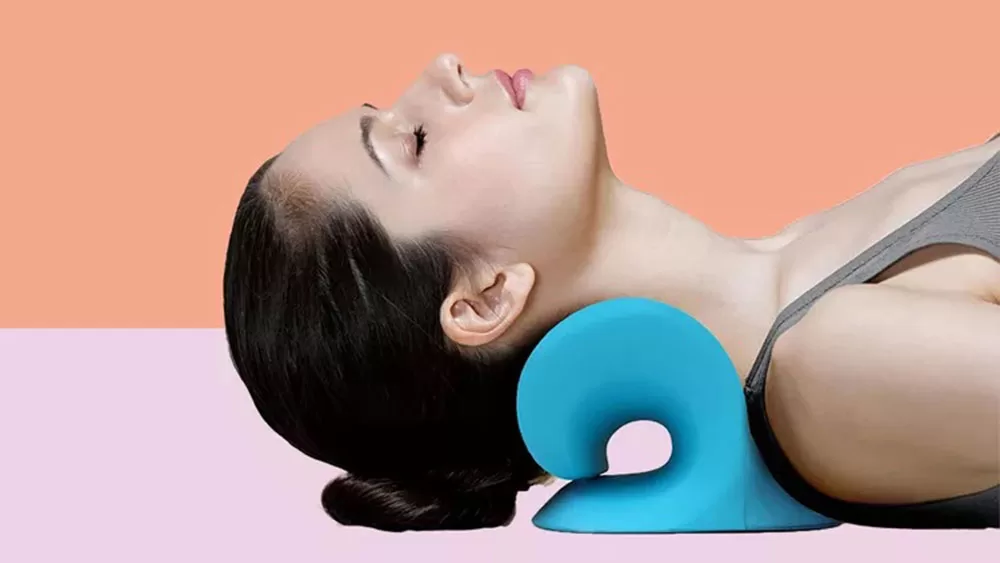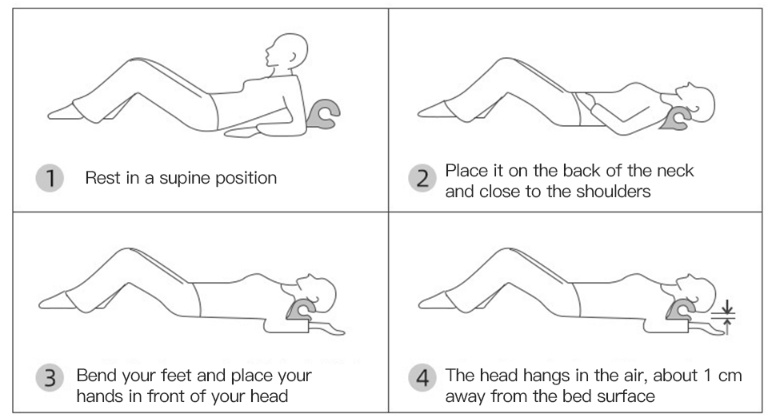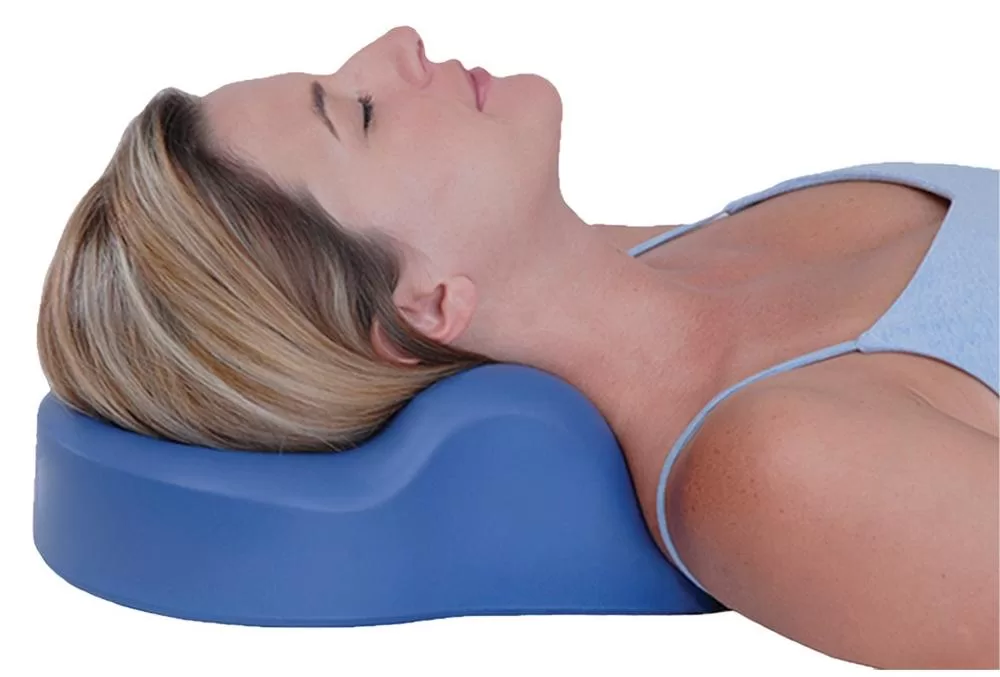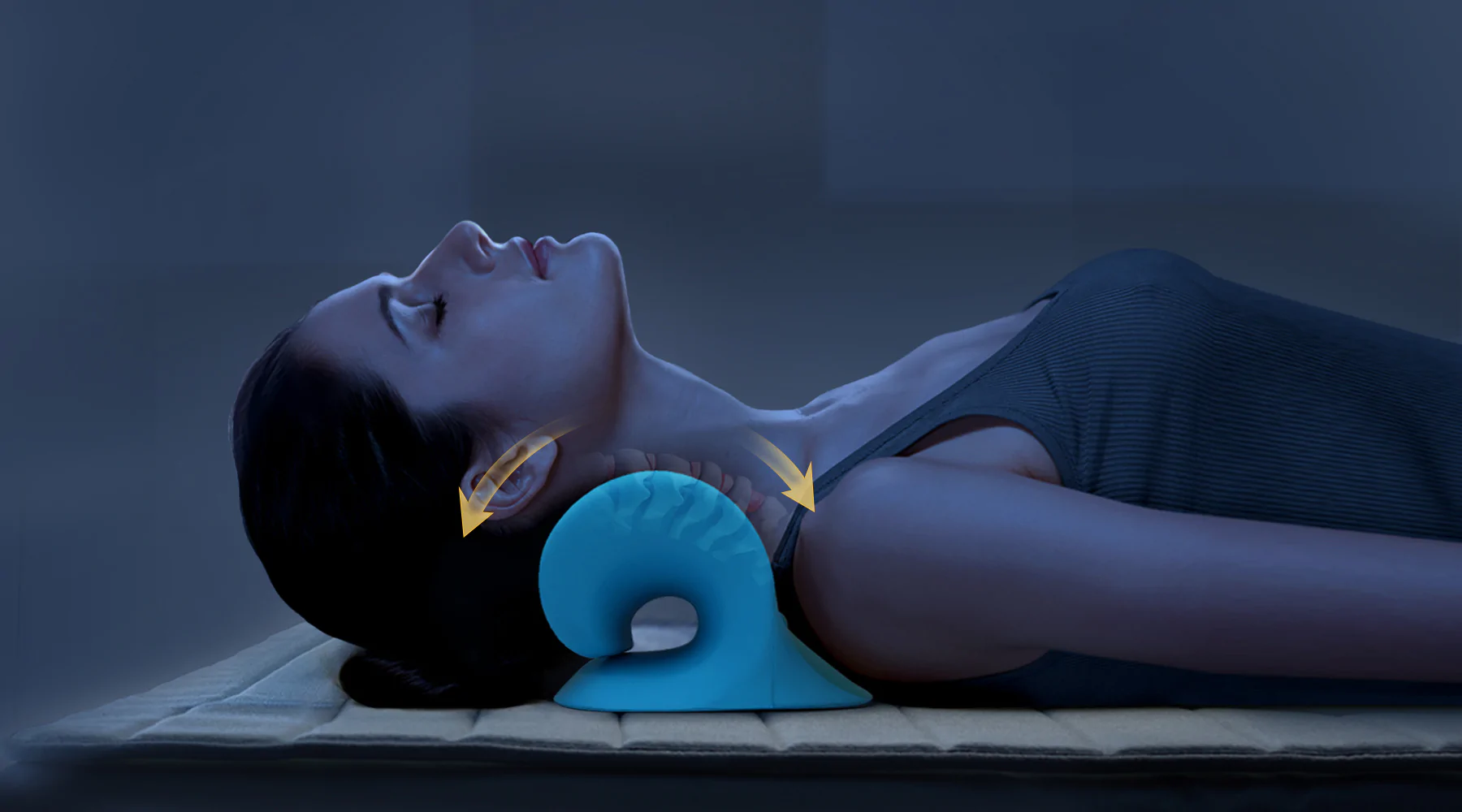With modern lifestyle changes, more and more people are facing cervical spine problems, such as neck pain, stiffness, and other related symptoms. In response to these problems, various cervical spine treatment aids have emerged in the market, of which the polyurethane cervical traction pillow is one of the most popular. It is an easy-to-use, safe, and reliable neck treatment tool that can relieve cervical pain and discomfort. This article will introduce the polyurethane cervical traction pillow in more detail, including its working principle, usage, and applicable people.

What is a Polyurethane Cervical Traction Pillow?
The polyurethane cervical traction pillow is a therapeutic aid for neck problems. It is primarily a cervical pillow made of polyurethane material with an ergonomic design that provides acupressure massage to the body to relieve cervical pain, stiffness, and other related symptoms.
When using a polyurethane cervical traction pillow, the user places it on a bed or chair and puts his or her head on the pillow to promote cervical extension and strengthen the muscles and ligaments around the cervical spine, thereby improving the range of motion of the cervical spine and relieving neck pain and discomfort. It is simple to use and has a certain degree of safety, but it is best to consult a doctor or professional before using it to ensure it is suitable for your neck problem.
What is the Working Principle?
Cervical traction is a treatment that relieves symptoms of neck pain, muscle tension, and nerve root compression by stretching the cervical spine. The polyurethane cervical traction pillow relieves neck pain by providing support and traction to allow for proper stretching and relaxation of the cervical spine.
The internal filling of the polyurethane cervical traction pillow is a polyurethane material that is flexible and it provides the proper support and pressure according to the shape of the head and neck. To use, place the pillow on a bed or flat surface, then lie on your back so that your neck is straight and relaxed. This allows for proper stretching and relaxation of the cervical spine, thus relieving neck pain.
What are the Advantages and Disadvantages?
Polyurethane cervical traction pillow is a common cervical massage device used to relieve cervical fatigue and pain, improve sleep quality and prevent the occurrence of cervical spondylosis.
Advantages of Polyurethane Neck Stretcher
- Relieve cervical spine fatigue: polyurethane cervical traction pillow can help reduce cervical spine muscle fatigue, promote blood circulation, and relieve cervical spine pain and stiffness.
- Improve sleep quality: The softness and elasticity of the polyurethane cervical traction pillow can provide good support and comfort, helping to improve sleep posture and sleep quality.
- Correct cervical spine posture: The use of a polyurethane cervical traction pillow can help correct incorrect cervical spine posture, maintain the natural curvature and stability of the cervical spine, and reduce the risk of cervical spondylosis.
- Promote blood circulation: polyurethane cervical traction pillow can promote blood circulation in the neck and increase the supply of oxygen and nutrients to the neck, thus helping to prevent the occurrence of cervical spondylosis.
- Prevent cervical spondylosis: long-term use of polyurethane cervical traction pillow can help prevent the occurrence of cervical spondylosis and protect the cervical spine from external pressure and injury.
Disadvantages of Polyurethane Neck Stretcher
- Individual differences: different people’s cervical spine conditions and use habits are different, and the adaptability of the polyurethane cervical traction pillow is also different, some people may not be suitable for use.
- Can not completely replace the medical means: polyurethane cervical traction pillow is only an auxiliary treatment tool, and can not completely replace the medical means. For people who already suffer from cervical spondylosis, it is recommended to use it under the guidance of a doctor.
- Need regular cleaning and replacement: polyurethane cervical traction pillow is easy to accumulate bacteria and dirt, and needs regular cleaning and replacement to ensure hygiene and use effect.
What are the Types?
According to the shape and classification, it can be generally summarized into the following six categories:
- U-shaped cervical pillow: this cervical pillow shape is U-shaped, suitable for sleeping or sitting on the sofa, and can provide comfortable support to relieve the fatigue of the cervical spine.
- C-shaped cervical pillow: this cervical pillow shape is C-shaped, can fix the head, relieve the pressure on the cervical spine, and prevent head tilt resulting in cervical spine injury.
- Air neck pillow: this cervical pillow built-in inflatable bag, so you can adjust the amount of inflation as needed, polyurethane material air neck pillow in providing comfortable support at the same time, but also achieves a better cervical traction effect.
- Massage neck pillow: this cervical pillow external massage equipment, can provide neck massage, relieve cervical pain and stiffness, and provide a more comfortable massage experience.
- Memory foam neck pillow: this cervical pillow using memory foam material, can adjust the shape and hardness according to the body’s temperature and weight, providing more snug neck support.
- Wave neck pillow: the surface of this neck pillow is wave-shaped, which can provide better neck support and a soft and comfortable fit.

Differences from Traditional Traction Pillows
The main difference between polyurethane cervical traction pillows and traditional traction pillows is their material and design.
First, polyurethane, a material with better softness and elasticity, can better adapt to the curve of the neck, thus better supporting and protecting the neck. Traditional traction pillows are usually made of memory foam, airbags, and other materials, which are relatively less soft and flexible and less suitable for the curve of the neck. Here it is necessary to mention that memory foam is a polyurethane foam-based, specially treated with memory function material, commonly used in the manufacture of mattresses, pillows, cushions, and other products, and polyurethane is related but not equivalent.
Secondly, polyurethane cervical traction pillows are more ergonomically designed with a higher pillow to better support the neck and maintain the natural curvature of the cervical spine, thus providing relief from cervical fatigue and pain. Traditional traction pillows, on the other hand, do not have the height and shape characteristics of polyurethane cervical traction pillows and may not provide enough support to achieve the same effect. Read this article for a more detailed comparison between them.
Correct Method of Use
Proper use of a polyurethane cervical traction pillow can relieve cervical pain and fatigue, improve sleep quality, and reduce the risk of cervical spine injury.
- Lying on a bed or flat surface, place a polyurethane cervical traction pillow under the head and neck, allowing the head and neck to rest naturally on the pillow.
- Adjust the position of the head and neck to fit the curve of your body, allowing the cervical spine to bend naturally and the head to maintain a straight line with the spine.
- The time to use the polyurethane cervical traction pillow should gradually increase, starting from a few minutes and gradually extending to about 30 minutes, with each use not exceeding one hour. It should not be used as an ordinary pillow for a whole night, otherwise, it may lead to cervical spine problems caused by excessive traction.
- When using the polyurethane cervical traction pillow, you can slowly relax the neck muscles in combination with breathing to enhance the relaxation effect.

What Diseases Can Be Treated?
Polyurethane cervical traction pillows can be used to relieve and assist in the treatment of a wide range of cervical spine-related disorders and discomforts.
- Cervical spondylosis: polyurethane cervical traction pillow can help reduce the pain and discomfort of cervical spondylosis and relieve stiffness and muscle tension in the neck.
- Cervical disc herniation: polyurethane cervical traction pillow can reduce the pressure on the cervical disc and relieve the pain and discomfort caused by cervical disc herniation.
- Cervical spine strain: polyurethane cervical spine traction pillow can relieve cervical spine fatigue and strain and help restore the cervical spine to a healthy state.
- Neck and shoulder pain: polyurethane cervical traction pillow can help reduce the symptoms of neck and shoulder pain and relax the muscles of the neck and shoulders.
- Headache: polyurethane cervical traction pillow can alleviate headaches caused by cervical spine problems and relieve the feeling of tension and stress.
It is important to note that the polyurethane cervical traction pillow does not cure these conditions, it is only an adjunctive treatment that can help alleviate symptoms and relieve discomfort. Before using a polyurethane cervical traction pillow, it is best to consult a doctor or professional to determine if it is suitable for use and to follow the correct method of use.
How to Choose the Right Pillow for You?
Choosing the right polyurethane cervical traction pillow for you requires consideration of several factors, and it is best to first understand your cervical spine problems and personal needs, choose the right product, and follow the correct method of use. At the same time, it is recommended to choose formal channels and brands when purchasing products to ensure product quality and safety.
- Material: Choose high-quality polyurethane material, with soft, comfortable, and durable characteristics, not easy to deform and loss of elasticity.
- Shape: Choose a suitable shape according to individual cervical curves and sleeping habits, such as U-shaped, C-shaped, W-shaped, etc. Different shapes of cervical spine traction pillows can provide different cervical support and traction effect.
- Height: Choose a cervical traction pillow with a height suitable for you to keep the neck and head in a natural position and posture. In general, the height of the cervical traction pillow should match the curvature of the individual’s cervical spine, too high or too low will be a burden on the cervical spine.
- Brand and quality: Choosing a well-known brand and high-quality cervical traction pillow will ensure the quality and reliability of the materials, production, and design, and avoid using low-quality products that may have a negative impact on the cervical spine.
- Price: Price does not necessarily represent the quality of the product, you can choose a cost-effective product according to your budget.
Precautions When Using
The use of polyurethane cervical traction pillows requires attention to proper usage, moderate usage, maintaining proper posture, and matching the appropriate pillow height. If discomfort occurs, you should stop using it in time and consult a doctor’s advice.
- Correct use: please read the product manual carefully before use, in accordance with the instructions on the correct use of cervical traction pillow, do not change the use of the method at will.
- Moderate use: the first use should be gradually adapted, starting from a few minutes, gradually increase the use of time, but at most not more than an hour, so as not to cause discomfort to the cervical spine.
- Maintain the correct posture: when using should maintain the natural posture of the neck and head, do not excessively tilt the head or head down to avoid additional pressure on the cervical spine.
- With the appropriate pillow height: when using the cervical traction pillow, you should choose the appropriate pillow height according to your cervical curvature and sleeping habits to ensure the natural posture of the neck and head.
- Do not confuse it with other traction methods: a cervical traction pillow is a special cervical traction tool, do not confuse it with other traction methods to avoid adverse effects on the cervical spine.
- Wash frequently: cervical traction pillow should be washed frequently to maintain cleanliness and hygiene.
Cleaning and Maintenance Methods
The cleaning and maintenance methods of the polyurethane cervical traction pillow are simple and consist of the following:
- After each use, wipe the surface stains with a clean cloth or paper towel to keep the pillow dry and clean.
- If the pillow surface is stained or stained heavily, you can use neutral detergent and warm water to gently wipe but do not use strong acids, strong alkalis, and other chemical cleaners.
- Do not soak the pillow when cleaning to avoid internal foam damage and moisture residue.
- Avoid prolonged exposure to sunlight or high temperature and humid environment to avoid affecting the life and quality of the pillow.
- Check the pillow regularly for wear and tear, gas leakage, and other problems, and replace it in time if necessary.
Who is Suitable for it?
It should be noted that for patients with serious cervical spine injuries and degenerative diseases of the cervical spine, it is necessary to use polyurethane cervical traction pillows under the guidance of a doctor.
- Cervical spondylosis patients: polyurethane cervical traction pillow can relieve cervical spondylosis caused by neck pain, stiffness, soreness, and other symptoms.
- For people who often use computers or cell phones: a long time to maintain the same posture is easy and causes cervical fatigue and discomfort, polyurethane cervical traction pillow can relieve cervical fatigue and prevent cervical spondylosis.
- Cervical spine strength requirements of the crowd: such as drivers, cabin crew, and other occupations need to maintain the same posture for a long time, polyurethane cervical traction pillow can relieve cervical fatigue, and reduce neck discomfort.
To see if you are suitable to use this product, why not take a look at the detailed description below?
| Object of use | Points to note | Conclusion |
| Seniors | 1. Cervical spondylosis situation: the elderly cervical spondylosis situation is relatively more, so you need to determine the specific situation and degree of cervical spondylosis to determine whether the polyurethane cervical traction pillow is suitable for use. 2. Traction strength: the elderly cervical spine bone density is relatively low, and the use of traction force too much cervical traction pillow may cause damage to the cervical spine, so you need to choose the traction strength suitable for the elderly. 3. Comfort: the elderly usually have high requirements for the comfort of the sleep environment, so you need to choose a soft and comfortable, breathable polyurethane cervical traction pillow. 4. Safety: the elderly body function is relatively weak, so the use of a cervical traction pillow needs to pay attention to safety, to prevent accidental injury. | Caution required |
| Teenagers | 1. Cervical spondylosis condition: adolescents are usually not prone to cervical spondylosis, so the need to use a cervical traction pillow needs to be determined on a case-by-case basis. 2. Posture problems: teenagers often use computers, cell phones, and other electronic devices, which may lead to cervical fatigue and discomfort if they maintain poor posture. The use of a cervical traction pillow can improve posture and relieve cervical fatigue. 3. Traction strength: adolescent cervical spine bones are not fully developed, and the use of traction force too much cervical traction pillow may cause damage to the cervical spine, so you need to choose the traction strength suitable for adolescents. 4. Comfort: adolescents have high requirements for the comfort of the sleep environment, so you need to choose a soft and comfortable, breathable polyurethane cervical spine traction pillow. 5. Safety: adolescent body function is in the developmental period, and the use of a cervical traction pillow needs to pay attention to safety, to prevent accidental injury. | Low necessity |
| Office workers | 1. Relieve cervical fatigue: office workers are sedentary office, have long-term fixed posture, easy to cause cervical fatigue and discomfort. The use of a polyurethane cervical traction pillow can improve cervical posture and relieve cervical fatigue and discomfort. 2. Improve the quality of sleep: polyurethane cervical traction pillow can provide a comfortable sleep environment and improve the quality of sleep. For office workers who often work overtime and stay up late, the use of a polyurethane cervical traction pillow can relieve cervical fatigue and discomfort, improve the quality of sleep and improve work efficiency. 3. Easy to carry: polyurethane cervical spine traction pillow is small in size, light in weight, and easy to carry. Commuters can carry it with them and use it anytime to relieve cervical fatigue and discomfort. 4. High comfort: polyurethane cervical traction pillow material is soft and comfortable, breathable, and very comfortable to use. | Suitability |
| Drivers | 1. Relieve cervical fatigue: Drivers maintain a posture for a long time, which can easily cause cervical fatigue and discomfort. The use of a polyurethane cervical traction pillow can improve cervical posture and relieve cervical fatigue and discomfort. 2. Improve driving posture: polyurethane cervical traction pillow can adjust the position of the neck and shoulders, improving driving posture, and making driving more comfortable and safe. 3. Convenient to carry: polyurethane cervical spine traction pillow is small, light, and easy to carry. Drivers can carry it with them and use it at any time to relieve cervical fatigue and discomfort. 4. High comfort: polyurethane cervical traction pillow material is soft and comfortable, breathable, and very comfortable to use. | Suitability |
| Cervical spine rehabilitation patients | 1. Choose the appropriate traction strength and height: cervical spine rehabilitation patients have different conditions, so when choosing a polyurethane cervical spine traction pillow, you should choose the appropriate traction strength and height according to your personal situation to avoid aggravating the symptoms of cervical spine disease. 2. Avoid over-dependence: Although the polyurethane cervical traction pillow can relieve cervical fatigue and discomfort, patients recovering from cervical spondylosis should not rely excessively on the cervical traction pillow, and should carry out appropriate exercise and rehabilitation treatment at the right time. 3. Can not replace the doctor’s treatment: polyurethane cervical traction pillow can not replace the doctor’s treatment, cervical spondylosis rehabilitation patients should follow the doctor’s advice, with the doctor’s treatment plan for rehabilitation treatment. | Suitable but with attention |
| Postoperative cervical spine patients | 1. Postoperative phase: During the postoperative recovery period, rehabilitation treatment needs to be carried out in strict compliance with the doctor’s instructions, and the use of polyurethane cervical traction pillows should be avoided to avoid affecting the surgical effect and recovery. 2. Postoperative stabilization period: In the postoperative stabilization period, if the condition has been controlled, the polyurethane cervical traction pillow can be used appropriately. However, care needs to be taken to select the appropriate traction strength and height to avoid discomfort caused by excessive traction force. 3. Special types of surgery: If a patient has undergone cervical spine surgery and a support implant is used (e.g., interbody fusion), medical advice needs to be followed to avoid negative effects on the outcome of the surgery. | Caution required |
| Pregnant or postpartum women | 1. Pregnancy: pregnant women using polyurethane cervical traction pillows need to follow the doctor’s advice, because the physiological condition of the cervical spine may change during pregnancy, such as changes in hormone levels and fetal compression, which may affect the health of the cervical spine. 2. Postpartum period: During the postpartum period, polyurethane cervical traction pillows can be used appropriately, but care needs to be taken to choose the appropriate traction strength and height to avoid negative effects on the body. 3. Lactation: postpartum women using polyurethane cervical traction pillows during breastfeeding need to be careful not to compress the breasts to avoid discomfort or poor milk flow to the breasts. | Consider carefully |
| Scoliosis of the cervical spine | Cervical scoliosis is a deformity of the cervical spine that places the cervical spine in an abnormally curved position, resulting in compression and strain on the muscles and nerves surrounding the cervical spine. Therefore, for patients with cervical scoliosis, the use of polyurethane cervical traction pillows may increase the pressure and strain on the cervical spine, leading to increased pain and discomfort. | Not recommended |
| Posterior cervical lordosis | Cervical kyphosis is a cervical spine deformity that causes the cervical spine to be in a backward convex position, causing compression and strain on the muscles and nerves surrounding the cervical spine. If a polyurethane cervical traction pillow is used, the height and shape of this pillow may allow the cervical spine to stretch backward excessively, which in turn increases the burden and symptoms of the cervical spine. | Not recommended |
| Herniated cervical disc | A herniated cervical disc is a common cervical spine disease that causes the cervical disc to bulge outward, compressing the surrounding nerves and blood vessels and causing symptoms such as neck pain and shoulder pain. Using a polyurethane cervical traction pillow can help reduce the pressure on the cervical spine, relax the neck muscles, and relieve pain and discomfort. 1. Confirm the condition: Confirm the condition of the cervical disc herniation and determine whether it is suitable for use. 2. Control the time and strength of use: The time and strength need to be properly controlled to avoid over-stretching the cervical discs and causing aggravation of the condition. 3. With other treatment methods: It can be used as an auxiliary treatment method, but it cannot replace other treatment methods, such as acupuncture, massage, and physiotherapy. | Use with caution |

Conclusion
Polyurethane cervical traction pillows are a breakthrough in sleep and health technology. Designed to alleviate neck pain and promote proper spinal alignment, they offer a comfortable and therapeutic solution for those seeking improved sleep quality and posture. Their unique design and material ensure durability and effectiveness, making them a valuable addition to any bedtime routine.


一个回复